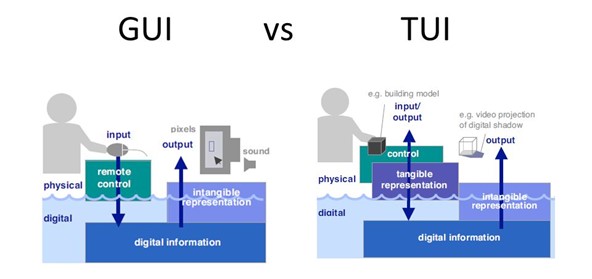This blogpost is the second part of my visit at the Museu de les Ciències (Príncipe Felipe). If you did not read the first part, you can follow this link:
Exhibition: Marte
The next exhibition had the topic “Mars” and was in terms of structure and environment very similar to the Terra Extraordinária exhibition. Again, a dark environment with walls colored in black, giving the exhibits a glowing effect. Unfortunately, not all installations were working as intended – a beamer projecting a quiz where one couldn’t read the text and a projection on to a book that was out of service because of technical issues.


While one projection on to a book didn’t work, there was a second one I wanted to try. The exhibit quickly got my interested as I remembered several projects working with interactive projections on to books. However, the overall impression could be described as a mixture of feelings. In my opinion, instead of the book, the beamer construction cached the eyes of visitors first, as it was not only the biggest object but also the one with the most complex shape. Instead of focusing on the book which should be the center, I began thinking of what the shape of the construction reminds me of.
Next to the projection there was a screen which I think let the visitor choose different books being projected. Unfortunately, the installation was occupied for a very long time so I could not try it out. However, I inspected the physical book being projected on. I found a very familiar hand tracking device in front of the books. As I had seen past projects that looked similar, I tried to turn a page with a gesture – unfortunately nothing happened.


Furthermore, the projection itself was not mapped very accurate, leafing a blank spot on the bottom.
What I liked in this context was, that a lot of physical books were placed around this exhibit letting the visitor connect to. In my opinion this linked the digital projection with real historical books. On the one hand the projection became more meaningful as the visitor could reference to the historical books and on the other hand the historical books being protected behind glass become more alive.

A second exhibit I would like to mention requires no interaction as it only serves to display information. However, it caught my eyes because of its construction. Compared to all the other exhibits in this exhibition, this is the only one being placed at a height of around 50cm ensuring a better accessibility.

Bosque de Cromosomas and Exposición Temporal
Finally, there were two additional smaller exhibitions about different scientific fields in natural science – ranging from chromosomes to human cells. By following the path indicated with numbers, visitors could discover scientific mechanisms.

Taking a closer look at the interfaces one could see that the following exhibition could stay for a longer period. Buttons, mouse, frames and actuators – everything was built with a clear focus on durability. The following photos demonstrate how this long-term exhibition was constructed.

As I was coming from the other exhibitions this one gave me a slightly brutal impression. However, based on the experience I made during the last year I can understand that exhibitions need to be built with durability in mind. In my opinion it can often be hard to find the right balance between visually appealing, sophisticated and durable exhibits that need a minimum amount of maintenance. However, I think a physical button can always be designed more attractive than a simple green knob.
Science Communication
Another important aspect for me was to analyze how the scientific content was being communicated. While complex topics need to be broken down without losing their scientific accuracy, user Interfaces should be as intuitive as possible.
In the “Pixer” exhibitions this was very well made as nearly all interfaces have been designed in the same layout. Button and slider had clear feedback, giving the user a lot of variations to explore without getting lost.
The “Terra Extraordinária” exhibition had a broad spectrum on user interfaces ranging from physical representations protected by glass boxes to tangible user interfaces. One exhibit that I really liked was the microscope showed in the “Terra Extraordinária” exhibition. On the one hand there was a very clear connection to the scientific process and on the other hand the big plate with knobs let people explore the different microscope slides in a pleasant and playful way. However, in terms of accessibility there could be some improvement – for example being able to access the exhibit with a wheelchair.
The “Marte” exhibition was structured like the “Terra Extraordinária” exhibition. One could see historical books but also more complex projections on to physical representations of books. Unfortunately, the experience was not as intuitive as in the previous exhibition – either an interface didn’t work as intended, or I could not connect the exhibit with a scientific context well.
Conclusion
After my visit at the museum, I came to the conclusion that highly sophisticated technical interfaces can in the first moment produce big “wow effects” but when in lack of a good concept become great obstacles. During my stay at the museum, I sometimes felt relieved when interacting with very simple interfaces as the focus shifted away from the interface and back to the actual topic the exhibit dealt with.












